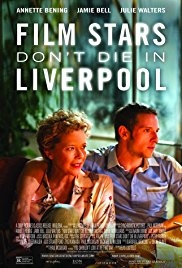Annette Bening pays tribute to a forgotten icon in Film Stars Don’t Die In Liverpool
Film Reviews Movie Review
Gloria Grahame isn’t nearly as well known as her contemporary Marilyn Monroe, but her story is an equally tragic example of the corrosive effects of Hollywood sexism. An early 1950s noir bombshell whose career began to decline less than five years after winning the Best Supporting Actress Oscar for 1952’s The Bad And The Beautiful, Grahame’s value to the Hollywood system began and ended with her beauty. Simultaneously celebrated and vilified for her sex appeal, Grahame remained obsessed with her looks until the end of her relatively short life, marrying four times and taking up lovers—some of them significantly younger than her—in between. It was an act of self-preservation as much as vanity: It was made clear to her early on that if no one found her attractive, she might as well be dead.
Now Grahame is the subject of her own My Week With Marilyn-style biopic, complete with an adoring young Englishman and a sensitive portrayal from a celebrated actress. In this case, that actress is Annette Bening, who plays Grahame in her twilight years in the late 1970s and early ’80s, doing regional theater in Liverpool, England after being exiled from Hollywood for an affair with her teenage stepson. That’s where she meets Peter Turner (Jamie Bell, a.k.a. the little boy from Billy Elliott all grown up), a yeoman actor several decades her junior who’s genuinely in awe of the woman he calls “Glo.” Enthralled by her charisma and celebrity, Peter falls hard—if anything, she’s the one with commitment issues—and the two begin a passionate affair. We open in medias res, as a terminally ill Grahame moves in to the modest row house Peter shares with his kind-hearted mom, Bella (Julie Walters), salt-of-the-earth dad, Joe (Kenneth Cranham), and nosy brother, Joe Jr. (Stephen Graham). From there, the film backtracks to Peter and Gloria meeting for the first time, jumping around in time as melodrama dictates.
That’s just one of several structural tricks used by screenwriter Matt Greenhalgh, a biopic specialist who also wrote the Ian Curtis biopic Control, John Lennon biopic Nowhere Boy, and Paul Raymond biopic The Look Of Love. The script was adapted from Turner’s own book about his life with Grahame, which gives it a certain sweetness and sympathy toward a woman who Turner really did love, even when she was being selfish and manipulative. In Turner’s eyes, Grahame is the silver-screen idol forever just out of reach, a beautiful mystery that he adores but can never really understand. That contradiction is reflected in Bening’s performance, portraying Grahame as a skittish, insecure woman who needs constant attention and reassurance but who, once things get serious, pushes people away for fear of hurting them—or of being hurt herself. And while Bening does a studied impression of Grahame’s supple body language, she uses a light touch when recreating her Betty Boop-esque voice, letting Grahame’s seductiveness ooze from her gorgeously refined pores.
That sense of restraint is completely lost on director Paul McGuigan, better known for crime thrillers like Lucky Number Slevin than romantic dramas like this one. In everything from the score to the costumes and hairstyling, McGuigan seems to think that there’s no such thing as too much, a lavishness that just isn’t supported by the film’s obviously modest budget. The result is some embarrassing wigs and the most heavy-handed ’70s set decoration this side of The Conjuring 2. That money would have been better spent on location shoots, instead of letting painfully obvious matte paintings and stagey rear projection stand in for the highways of Southern California and skyline of New York City—which would have been fine, if they were used for stylistic effect à la Pulp Fiction. Alas, as the cringeworthy folk cover of “California Dreamin’” makes clear, they were not. Combined with the similarly heavy-handed sentimentality of the film’s romantic scenes, the effect is akin to pouring half a bottle of soy sauce onto an exquisite piece of sashimi. It just isn’t necessary to add so much flavoring, especially to quality raw materials like Annette Bening and Gloria Grahame.